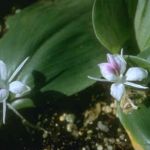| Common Name: |
Resurrection lily |
| Botanical Name: |
Kaempferia galanga |
| Genus: |
Kaempferia |
| Family: |
Zingeiberaceae |
| Location: |
India, China |
| Cultivation: |
Rich, moist soil in shade, with high humidity. Kaempferias must be kept dry when dormant. |
| Propagation: |
By seed sown when ripe at 20°C (68°F); by division in spring. |
| Harvest: |
Rhizomes are lifted during during dormancy, and used fresh as a vegetable, or dried for use in decoctions, poultices, and powders. |
| Height: |
30cm (12in) |
| Width: |
30-60cm (12-24in) |
| Hardiness: |
Z9-11 |
| Parts Used: |
Rhizomes |
| Properties: |
A bitter, stimulant herb with a camphoraceous aroma. It is anti-bacterial, improves digestion, and has diuretic effects. |
| Medicinal Uses: |
Internally for bronchial complaints, dyspepsia, and headaches. Externally for wounds, dandruff, lice infestations, rheumatic joints, and as a gargle for sore throat. Compined with Alpina galanga (See, galagal), Cucurma longa (See, turmeric), and Zingiber spp. (See, ginger) as awas empas, an Indonesian recipe for stiff joints, headaches, and urinary tract complaints. |
| Culinary Uses: |
Fresh rhizomes and young shoots are pickled, eaten raw, or cooked as vegetables. Dried rhizomes are used to flavor rice and as a substitute for turmeric. |
| Economic Uses: |
Powdered rhizome is added to body powders and cosmetics; also used in linen sachets. |
| Bibliography: |
Encylopedia of Herbs by Deni Brown Copyright ©: 1995, 2001 Dorling Kindersley Limited pg 249
|

